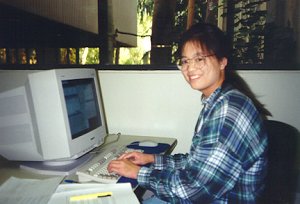



Caltech Summer Research Program Prepares Students for Graduate School
|
Elaine Cheong, a sophomore majoring in Electrical Engineering at the University of Maryland, says she has been interested in computer science since she took her first programming course in high school. "Since I've started college, I've been trying to learn as much as possible about both hardware and software," she says. "This summer is a good opportunity to learn more about object-oriented programming. This will provide a good background in system design and will be useful no matter what field I choose to pursue in my career."
Cheong is one of four students participating in this year's Caltech Summer Research Program in Parallel Computing for Undergraduate Women. The other participants are Sherian Clay, a sophomore in Computer Science at Hampton University; Joyeeta Dutta, a junior in Biological Basis of Behavior and Computer Science & Engineering at the University of Pennsylvania; and Mary Ishibishi, a junior in Computer Science at the University of Maryland. Now in its ninth year, the annual CRPC-sponsored program offers participants the opportunity to spend two to three months working on projects with Caltech professors, researchers, and graduate students. Students typically select an area of interest, learn how to develop programs for parallel computers, and then use the computers to solve a problem in that area. Cheong is working on creating a Java preprocessor. "This tool will help programmers with code beautification, code standard conformance, and documentation checking," she explains. "It will also check and transform user-specified code requirements, such as preconditions, postconditions, and class invariants. Hopefully, this will be useful to programmers working in a distributed environment." Clay is developing a Graphical User Interface (GUI) using Java. "A GUI is a graphical interface to a computer," she says. "It refers to the techniques involved in using graphics, along with the keyboard and the mouse. Elements of GUI include icons, scroll bars, buttons, and menus. It provides an easy-to-use interface to some programs." Clay's GUI will have applications to Ishibishi's project. "I'm working on a dynamic user directory that can be accessed by Internet tele/video-conferencing applications," says Ishibishi. "Right now, I'm looking at an implementation of a directory service to which we hope to add the dynamic extensions." About the summer program in general, she says, "I think this is a great opportunity to be exposed to doing research, and that's why I wanted to come to Caltech." "I am enjoying the program, and I like the flexibility and opportunities that the program offers," says Dutta. Dutta is working in the Computation and Neural Systems Department, studying information transfer in Purkinje cells in the cerebellum. "My work involves applying information theory to characterize the communication channel, using neural simulations, and also studying the robustness and fault tolerance of the system," she says. "I'm glad I met the other participants in this program," concludes Cheong. "Together, we have fun going to seminars, barbecues, and movies with other Caltech undergraduates who we met in our dormitory. I am learning what it's like to be a graduate student, and I look forward to applying to graduate school in the future." Applications for Caltech's Summer Research Programs in Parallel Computing for Undergraduate Women are distributed to universities nationwide each fall. For more information, see http://www.ama.caltech.edu/~joann/crpc/sugp97.html or contact JoAnn Boyd at joann@ama.caltech.edu. |
 Elaine Cheong
Elaine Cheong
|